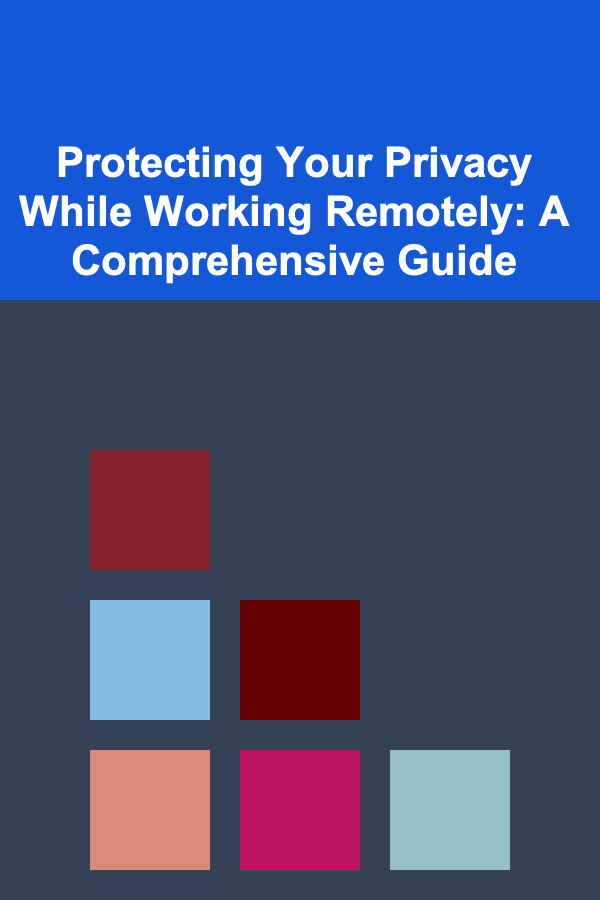
Protecting Your Privacy While Working Remotely: A Comprehensive Guide
ebook include PDF & Audio bundle (Micro Guide)
$12.99$8.99
Limited Time Offer! Order within the next:

The shift towards remote work has brought numerous benefits, including increased flexibility and autonomy. However, it has also introduced new privacy challenges. Working from home blurs the lines between our personal and professional lives, creating vulnerabilities that malicious actors can exploit. Protecting your privacy while working remotely is crucial for maintaining data security, safeguarding your personal information, and preserving your peace of mind. This comprehensive guide provides in-depth strategies and practical tips to help you navigate the privacy landscape of remote work effectively.
Understanding the Privacy Risks of Remote Work
Before diving into solutions, it's essential to understand the specific privacy risks that remote workers face. These risks stem from a variety of factors, including unsecured home networks, the use of personal devices for work purposes, and the increased reliance on digital communication tools. Ignoring these risks can lead to serious consequences, from data breaches and identity theft to reputational damage and legal repercussions for both you and your employer.
Unsecured Home Networks
Home networks are often less secure than corporate networks, making them prime targets for cyberattacks. Common vulnerabilities include:
- Weak Passwords: Using default router passwords or easily guessable passwords.
- Outdated Firmware: Failing to update router firmware, leaving known security vulnerabilities unpatched.
- Lack of Encryption: Not using WPA2 or WPA3 encryption for your Wi-Fi network.
- Unsecured IoT Devices: Connecting vulnerable "smart" devices (e.g., smart TVs, smart speakers) to the same network as your work devices.
An attacker gaining access to your home network can intercept your internet traffic, steal your personal data, and even access your work-related files and systems. This is especially concerning if you handle sensitive information like customer data, financial records, or intellectual property.
Personal Devices for Work
Using personal devices (e.g., laptops, smartphones, tablets) for work purposes introduces several privacy risks:
- Lack of Security Software: Personal devices may not have the same level of security software as company-issued devices, such as antivirus, anti-malware, and intrusion detection systems.
- Compromised Security Posture: Personal devices may be infected with malware or compromised due to risky online behavior.
- Data Mixing: Mixing personal and work data on the same device increases the risk of accidental data leakage or unauthorized access.
- Inadequate Password Management: Relying on weak or reused passwords across multiple personal and work accounts.
If a personal device is compromised, the attacker could potentially gain access to your work accounts, steal sensitive data, and even use your device to launch attacks against your company's network. Additionally, your personal data on the device could be exposed if it's lost or stolen.
Digital Communication and Collaboration Tools
Remote work relies heavily on digital communication and collaboration tools like email, instant messaging, video conferencing, and file sharing platforms. These tools can introduce privacy risks if not used securely:
- Unencrypted Communication: Using unencrypted communication channels can expose your messages and data to interception by eavesdroppers.
- Phishing Attacks: Increased reliance on email and messaging makes you more vulnerable to phishing attacks, which can trick you into revealing sensitive information or downloading malware.
- Data Breaches: Cloud-based collaboration tools are potential targets for data breaches, which can expose your work-related data and personal information.
- Lack of Privacy Controls: Failing to understand and configure the privacy settings of these tools can lead to unintended data sharing or exposure.
Imagine a scenario where you discuss confidential client information during a video conference call that is not properly secured. An attacker could potentially eavesdrop on the conversation and steal valuable business secrets.
Physical Security Concerns
Remote work also presents physical security concerns, especially when dealing with sensitive information:
- Data Exposure in Public Places: Working in public places (e.g., coffee shops, libraries) can expose your screen and conversations to prying eyes.
- Unsecured Physical Documents: Leaving sensitive documents unattended in your home can create a risk of unauthorized access.
- Family Members Accessing Work Devices: Family members may inadvertently access your work devices or data, potentially violating confidentiality agreements.
Consider the scenario where a roommate uses your unlocked work laptop to browse the internet, unknowingly downloading malware that compromises your work account.
Strategies for Protecting Your Privacy
Now that we've identified the key privacy risks, let's explore practical strategies to mitigate them.
Securing Your Home Network
Protecting your home network is the first line of defense against cyberattacks. Follow these steps to enhance your network security:
- Change Default Router Password: Access your router's settings and change the default password to a strong, unique password. Refer to your router's manual for instructions.
- Update Router Firmware: Regularly check for and install firmware updates for your router. These updates often include security patches that address known vulnerabilities. Most routers have an automatic update option; enable it.
- Enable WPA2 or WPA3 Encryption: Use WPA2 or, preferably, WPA3 encryption for your Wi-Fi network. This encrypts your wireless traffic, making it more difficult for attackers to intercept your data.
- Create a Guest Network: Create a separate guest network for visitors and IoT devices. This isolates these devices from your main network, preventing them from accessing your sensitive data if they become compromised.
- Enable Firewall: Ensure that your router's built-in firewall is enabled. This acts as a barrier between your network and the outside world, blocking unauthorized access attempts.
- Disable Remote Access (Unless Needed): If you don't need to access your router remotely, disable the remote access feature. This reduces the risk of attackers gaining access to your router through the internet.
- Consider a VPN: A Virtual Private Network (VPN) encrypts all of your internet traffic, providing an extra layer of security, especially when using public Wi-Fi networks. Choose a reputable VPN provider with a strong privacy policy.
Tip: Regularly scan your home network for vulnerabilities using a network scanning tool. These tools can help you identify weak passwords, open ports, and other security issues.
Securing Your Devices
Protecting your devices is crucial for preventing data breaches and unauthorized access. Implement these security measures on all devices you use for work, whether they are company-issued or personal:
- Install Antivirus and Anti-Malware Software: Install reputable antivirus and anti-malware software and keep it up to date. These programs can detect and remove malicious software that could compromise your device and steal your data.
- Enable a Strong Password or Biometric Authentication: Use a strong, unique password or biometric authentication (e.g., fingerprint, facial recognition) to protect your device from unauthorized access.
- Enable Two-Factor Authentication (2FA): Enable two-factor authentication (2FA) for all your important accounts, including email, banking, and social media. 2FA adds an extra layer of security by requiring a second authentication factor (e.g., a code sent to your phone) in addition to your password.
- Keep Software Updated: Regularly update your operating system and software applications. These updates often include security patches that address known vulnerabilities. Enable automatic updates whenever possible.
- Encrypt Your Hard Drive: Encrypting your hard drive protects your data from unauthorized access if your device is lost or stolen. Most operating systems have built-in encryption tools. Use them.
- Install a Firewall (If Applicable): For personal devices, ensure a personal firewall is active. This can block unauthorized incoming and outgoing network connections.
- Use a Password Manager: A password manager can generate and store strong, unique passwords for all your accounts. This eliminates the need to reuse passwords and reduces the risk of password-related breaches.
- Securely Dispose of Old Devices: When disposing of old devices, ensure that you wipe the hard drive and remove all personal and work-related data. Use a data wiping tool or physically destroy the hard drive.
- Consider Device Management Software: If using a personal device for work, discuss with your IT department about installing device management software. This allows your company to remotely manage and secure the device, potentially including features like remote wiping and data encryption.
Warning: Avoid clicking on suspicious links or opening attachments from unknown senders. These could contain malware or phishing scams designed to steal your information.
Securing Digital Communication and Collaboration
Protecting your communication and collaboration channels is essential for maintaining confidentiality and preventing data breaches. Implement these security measures when using digital communication tools:
- Use Encrypted Communication Channels: Use encrypted communication channels like Signal, WhatsApp (with end-to-end encryption enabled), or secure email providers like ProtonMail for sensitive communications.
- Verify Sender Identity: Before responding to emails or messages, verify the sender's identity, especially if the message requests sensitive information or contains links or attachments. Contact the sender through a different channel (e.g., phone call) to confirm the request.
- Be Wary of Phishing Attacks: Be cautious of phishing emails or messages that attempt to trick you into revealing sensitive information. Look for red flags like spelling errors, grammatical mistakes, and urgent requests.
- Use Strong Passwords for Collaboration Tools: Use strong, unique passwords for all your collaboration tool accounts. Enable two-factor authentication whenever possible.
- Review Privacy Settings of Collaboration Tools: Understand and configure the privacy settings of your collaboration tools to control who can access your data and communications. Disable features like location tracking and data sharing if you don't need them.
- Use Video Conferencing Security Features: When using video conferencing tools, use features like meeting passwords, waiting rooms, and screen sharing restrictions to prevent unauthorized access.
- Securely Share Files: Use secure file sharing platforms with encryption and access controls to share sensitive files. Avoid sharing files through unencrypted email or public cloud storage services.
- Be Mindful of Your Surroundings During Video Calls: Ensure that your background is clear of any sensitive information or personal items during video calls. Consider using a virtual background or blurring your background.
Remember to regularly update your communication software to patch security vulnerabilities. Also, educate yourself about the specific security features offered by each platform you use.
Enhancing Physical Security
Don't neglect physical security measures, especially when working with sensitive information at home:
- Secure Your Work Area: Create a dedicated workspace that is separate from your personal living space. This helps to minimize distractions and prevent unauthorized access to your work-related materials.
- Lock Your Computer When Away: Always lock your computer when you step away from your desk, even for a short period of time. This prevents unauthorized access to your data if someone enters your workspace.
- Shred Sensitive Documents: Shred sensitive documents (e.g., printouts, invoices, contracts) before discarding them. This prevents dumpster diving and unauthorized access to your confidential information.
- Be Aware of Your Surroundings in Public Places: When working in public places, be aware of your surroundings and take steps to protect your screen from prying eyes. Use a privacy screen filter or position yourself in a way that makes it difficult for others to see your screen.
- Educate Family Members: Educate your family members about your work and the importance of maintaining confidentiality. Explain the risks of accessing your work devices or data without permission.
- Secure Sensitive Equipment: If your work involves sensitive equipment (e.g., specialized hardware), ensure it is stored securely and inaccessible to unauthorized individuals.
Developing a routine for physical security is just as important as digital security. Make it a habit to lock your computer, shred documents, and secure your workspace every day.
Data Minimization and Privacy Policies
Beyond technical measures, consider the following principles:
- Data Minimization: Only collect and retain data that is absolutely necessary for your work. Avoid storing unnecessary personal information or work-related data on your devices.
- Understand Your Company's Privacy Policy: Familiarize yourself with your company's privacy policy and data security procedures. Understand your responsibilities for protecting sensitive information.
- Ask Questions: If you have any questions about your company's privacy practices, don't hesitate to ask your IT department or privacy officer.
- Regularly Review Your Privacy Practices: Periodically review your privacy practices and identify areas for improvement. Stay informed about the latest privacy threats and security best practices.
- Dispose of Data Properly: When data is no longer needed, securely delete it. Follow your company's data disposal policies.
Data minimization is a powerful privacy principle. The less data you collect and store, the less risk there is of it being compromised.
Special Considerations for Different Roles and Industries
The specific privacy risks and security measures required will vary depending on your role and industry. For example, healthcare workers and financial professionals handle particularly sensitive information and must adhere to strict regulations. Here are some role-specific considerations:
Healthcare Professionals
- HIPAA Compliance: Healthcare professionals must comply with the Health Insurance Portability and Accountability Act (HIPAA), which sets strict standards for protecting patient privacy.
- Secure Electronic Health Records (EHRs): Use secure EHR systems with access controls and audit trails to protect patient data.
- Encrypt Communication: Use encrypted communication channels for transmitting patient information.
- Securely Dispose of Patient Records: Properly dispose of patient records when they are no longer needed, following HIPAA guidelines.
Financial Professionals
- Financial Regulations: Financial professionals must comply with various financial regulations, such as the Gramm-Leach-Bliley Act (GLBA), which requires them to protect customer financial information.
- Secure Customer Data: Implement strong security measures to protect customer financial data, including encryption, access controls, and fraud detection systems.
- Prevent Insider Threats: Implement measures to prevent insider threats, such as background checks and access controls.
- Comply with Data Breach Notification Laws: Understand and comply with data breach notification laws, which require you to notify customers and regulators in the event of a data breach.
Legal Professionals
- Attorney-Client Privilege: Legal professionals must protect attorney-client privilege, which protects confidential communications between attorneys and their clients.
- Secure Client Data: Implement strong security measures to protect client data, including encryption, access controls, and data loss prevention (DLP) systems.
- Comply with Ethical Rules: Comply with ethical rules that require attorneys to maintain client confidentiality.
- Secure Communication Channels: Use secure communication channels to communicate with clients and colleagues.
Developers and Engineers
- Secure Coding Practices: Implement secure coding practices to prevent vulnerabilities in software applications.
- Protect Intellectual Property: Protect intellectual property, such as source code and designs, from unauthorized access and disclosure.
- Secure Remote Access: Secure remote access to development environments and servers.
- Comply with Data Privacy Regulations: Comply with data privacy regulations, such as GDPR and CCPA, when developing applications that collect or process personal data.
Staying Informed and Adapting
The privacy landscape is constantly evolving, so it's important to stay informed about the latest threats and security best practices. Here are some tips for staying up-to-date:
- Follow Security News and Blogs: Follow security news websites and blogs to stay informed about the latest threats and vulnerabilities.
- Attend Security Conferences and Webinars: Attend security conferences and webinars to learn from experts and network with other professionals.
- Take Online Security Courses: Take online security courses to improve your knowledge and skills.
- Join Security Communities: Join security communities and forums to share information and learn from others.
- Regularly Review Your Security Practices: Periodically review your security practices and update them as needed.
Remember that privacy is not a one-time fix, but an ongoing process. By staying informed and adapting your security measures, you can effectively protect your privacy while working remotely.
Conclusion
Protecting your privacy while working remotely is a complex but essential task. By understanding the privacy risks, implementing the strategies outlined in this guide, and staying informed about the latest threats and best practices, you can significantly reduce your risk of data breaches, identity theft, and other privacy-related problems. Remember to prioritize security in all aspects of your remote work, from securing your home network to protecting your devices and communication channels. A proactive and vigilant approach to privacy will not only safeguard your personal information but also protect your employer's data and reputation. Ultimately, a commitment to privacy fosters a secure and trustworthy remote work environment for everyone.

How to Create Engaging Pet Content to Attract Customers
Read More
How to Organize Children's Clothing by Season
Read More
How to Use Vertical Storage Solutions in Your Apartment
Read More
How To Write a Resume That Highlights Remote Work Skills
Read More
Incorporating Ozone Therapy for Wellness
Read More
Grasping the Concept of Being
Read MoreOther Products

How to Create Engaging Pet Content to Attract Customers
Read More
How to Organize Children's Clothing by Season
Read More
How to Use Vertical Storage Solutions in Your Apartment
Read More
How To Write a Resume That Highlights Remote Work Skills
Read More
Incorporating Ozone Therapy for Wellness
Read More